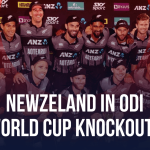The role of lower-order batsmen, or the tail, in ODIs has seen a paradigm shift over the last two decades. Batting positions 7-11, which once consisted of just poor batsmen, now have players with specific skill sets who can turn a game from the brink of defeat.
Having a singular skill set does not guarantee a spot in the playing eleven anymore, and the extinction of positions like a specific wicketkeeper is the perfect example of the same. The most recent evolution of the lower order was showcased by England during the 2019 ODI World Cup, where the team had Chris Woakes, Liam Plunkett, Jofra Archer and Adil Rashid coming in positions 7, 8, 9 and 10.
However, while England’s approach of batting right down till the end did win them the 2019 World Cup in their backyard, it might not be a great blueprint for all teams in World Cup 2023. Choosing a team’s lower order depends largely on their strengths and weaknesses.
An Indian team consisting of Ravindra Jadeja and Kuldeep Yadav can dominate and crumble opponents’ batting order in the middle overs, which is a luxury that teams like England or New Zealand don’t have. Hence, they have little option than batting deep. Teams like Afghanistan, Sri Lanka or Bangladesh use India’s strategy to some extent, although their spinners lack the same quality.
Hence, it is no surprise that no teams from the subcontinent actually rank in the list of top three teams with strong lower-order batsmen in the 2023 ODI World Cup.
Lower Order Batsmen in ODI: Top 3 teams
1. England
This is a no-brainer. England was the first team to come up with a strong lower-order batting line-up and show the world what it could achieve. A disciple of Brendon McCullum, it was Eoin Morgan who assembled a team that could bat from top to bottom with the same aggression. While the move was risky, England has crossed the threshold of 400 numerous times over the past five years with this approach.
Position 7 & 8: Liam Livingstone & Sam Curran
England’s lower-order batsmen are unrivalled in terms of experience in the tail-end positions. Liam Livingstone comes at no. 7 for them having tallied 229 runs in eight matches from that slot. He is followed by star all-rounder Sam Curran who has 180+ and 300+ runs from the eighth and ninth positions, respectively.
Position 9 & 10: Chris Woakes & Adil Rashid
Livingstone and Curran are further followed by Chris Woakes and Adil Rashid. A regular fixture in England for the past few years now, Woakes has 1000+ runs in the 8th position and 300+ runs from the ninth. Rashid might not be a pinch-hitter like Woakes or Curran, but he is steady with the willow coming in at the 10th position.
2. New Zealand
It wasn’t a surprise that New Zealand had reached the final in the 2019 World Cup and almost won the trophy in the final before the rule of boundaries snatched it back from them. While England had exacted the process of a rich lower-order after Morgan was appointed the skipper in 2015, it was New Zealand skipper McCullum who had first envisioned it and assembled a team during the 2015 World Cup, when the Kiwis would lose to Australia in the final.
The only difference between the two sides has been the talent pool each country has. The rise of names like Curran, Archer and Livingstone gave England the edge. However, New Zealand are just behind England in terms of a deep batting order.
Position 7 & 8: Mark Chapman & James Neesham
Primarily a middle-order batsman who has tallied 250+ runs from the fourth position and 100+ runs from the fifth across 10 matches, Mark Chapman is a luxury to come at number 7. He can rotate the strike, whack the ball out of the park as well as see off a match with equal ease. He is followed by veteran James Neesham, who has a whopping 847 runs from the sixth position and 311 runs coming at number seven. Neesham’s importance was cemented in the 2019 WC final.
Position 9 & 10: Mitchell Santner & Matt Henry
Having a veteran like Mitchell Santner coming in at number 9 is a blessing. The spinner all-rounder is equally handy with the ball and bat, having tallied 1000+ runs from the eighth position. Matt Henry comes after Santner and although he isn’t a specialized batter, he has over 100+ runs from both ninth and tenth positions.
3. Australia
The only reason Australia has the third-best lower order in the World Cup is because of the lack of their team’s batting experience at the tail. Despite not being as dominant as in the early 2000s anymore, Australia has managed to stay relevant by winning the 2015 ODI WC and the 2021 T20 World Cup. It is evident that there is no dearth of cricketing talent Down Under no matter how lesser-known the names are.
Position 7 & 8: Cameron Green & Pat Cummins
At no 7, Australia has a great talent in Green but he is yet to experience the pressure of the lower order, tallying just 229 runs in that position. Australia’s crumble against India was a perfect testament to his lack of experience. Green is followed by captain Pat Cummins, who has been around the block for years now, tallying 180+ runs in no.8 and 190+ runs in no. 9.
Position 9 & 10: Mitchell Starc & Adam Zampa
Like Cummins, Starc is a reliable batsman coming at number 9 with over 300+ runs in that position and over 100 runs at 10. Spinner Zampa is relatively new, tallying almost 150 runs from the 10th spot. However, Australia will hope it never comes to him.
Here are the top lower order batsmen in ODI World Cup teams. Most of them have already shown their prowess beyond being termed as ‘tails’.
For More Info you may also read about Top 5 Biggest Wins in ODI World Cup by Runs








